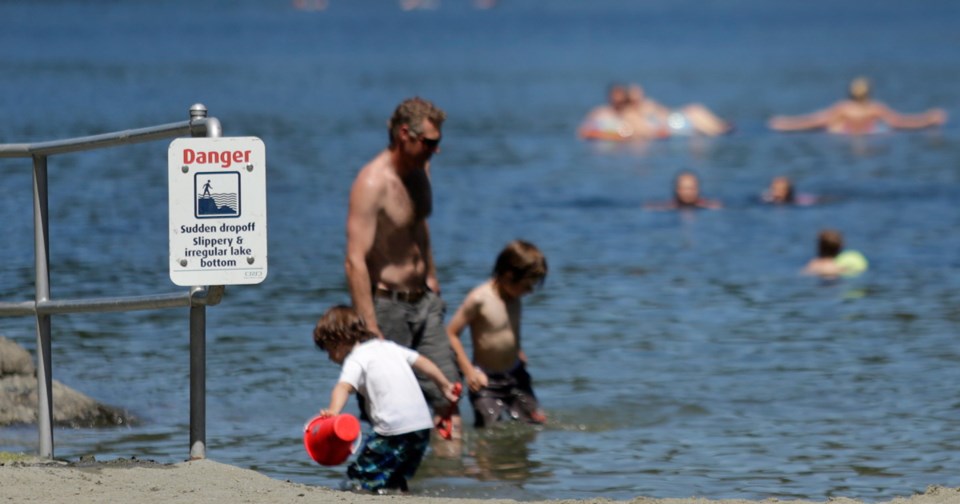As warm weather beckons and staycations kick into high gear this long weekend, officials are warning about potential drownings due to risky behaviour such as cliff jumping and swimmer inexperience on the province’s rivers and lakes.
The B.C. Lifesaving Society has reported 21 drownings so far this year, including the death of a woman in Matheson Lake on July 22. That’s about half the 45 people who die from drowning each year, according to provincial government data. However, the outdoor swimming season is really only starting as the weather warms.
A man was also injured this month after jumping off a cliff at Thetis Lake. It’s a persistent problem for rescuers at the regional park, where firefighters respond to five or six serious accidents every summer, said View Royal Fire Chief Paul Hurst.
A report by B.C. Hydro ahead of the long weekend says people are overestimating their swimming abilities, taking extreme chances and going into the water after consuming cannabis or alcohol.
An online survey conducted between June 18 and 22 included 600 people and revealed 85 per cent of respondents rated themselves as experienced swimmers, even though most do not swim often and haven’t had a formal swimming lesson in more than 10 years. An additional 10 per cent said they’ve never completed a lesson.
B.C. Hydro manages 19 recreation areas, including parks and beaches near power-generating sites that draw two million visitors a year. With the pandemic and staycations increasing, those numbers are expected to increase across the province.
“The potential for drownings is always a concern at this time of year, when the weather is warm and people want to head out to our lakes and rivers,” said Dale Miller, executive director of the B.C. Yukon Lifesaving Society. “What we want is for people to think ahead … what are you going to do if a member of your group gets into trouble?”
Miller said of the 21 drownings this year, 10 of the victims never expected to be in the water. He said they got into a boat or kayak and something unexpected happened. “You should have lifejackets, you should have the right equipment — like something to throw someone in distress,” he said.
The B.C. Hydro report found lack of experience and practice might be the reason why almost 30 per cent of British Columbians say they have had a near-drowning experience and 53 per cent have witnessed another person in the water in distress.
The survey also found almost half of respondents confess to going in the water under the influence of alcohol or marijuana. About 20 per cent admit to swimming in restricted areas. More than 40 per cent of parents acknowledged being somewhat distracted when their children are in the water.
Many also admit to not using personal floatation devices, including 24 per cent of boaters, 27 per cent of kayakers, 28 per cent of canoe users and 58 per cent of tubers.
The survey said men are 30 per cent more likely to be under the influence than women when swimming. Of those admitting to swimming out of bounds, 70 per cent were men. “This is especially dangerous at B.C. Hydro’s recreation sites,” the report said. “Many of these sites are located on working reservoirs, meaning there are dam structures that can be dangerous if signage is not obeyed and distance is not maintained.”
Water levels can change quickly in response to power demand.
“Swimming in an uncontrolled environment such as a lake or river is much more dangerous than in a controlled environment, such as a pool, because of the currents, sudden temperature changes and drop points, and unpredictable weather,” the report said.
Miller noted that about 80 per cent of drownings each year involve men, many of them younger and taking chances on the water. Most are between the ages of 20 and 34.
“It’s tough to convince them not to take that risky behaviour,” he said of cliff jumping or long swims in unknown waters. “If they have to do it, we ask you or those in the group to think ahead and plan for what could happen.
“It’s one thing to swim in a pool, but jumping into a deep, cold lake or a river with currents is quite different,” said Miller. “There is also the fatigue that can occur. That swim out to that dock in the lake can be overwhelming and people get into trouble.”
Hurst said that cliff jumping at Thetis Lake is a major concern.
Over the past two decades, there have been six drownings and dozens of people have been injured after jumping from the cliffs at the lake.
Hurst is meeting with Capital Regional District officials next week to discuss ways to address the issue. “It’s frustrating that we have to keep doing this over and over again,” Hurst said. “Something has to be done. We will still show up and clean up the mess, but I don’t know what it’s going to take to stop it.”
The online survey has a margin of error of plus or minus four per cent, 19 times out of 20.
— With files from The Canadian Press



